Contributory members are able to log private notes and comments about each site
Sites Anne T has logged. View this log as a table or view the most recent logs from everyone
Holy Well (Belstone)
Trip No.132 Entry No.14 Date Added: 9th Jun 2019
Site Type: Holy Well or Sacred Spring
Country: England (Devon)
Visited: Yes on 13th May 2019. My rating: Condition 3 Ambience 4 Access 4
Holy Well (Belstone) submitted by KiwiBetsy on 29th Aug 2006. This is a curative spring located near St Mary’s Church. The spring is protected by several large granite rocks.
(View photo, vote or add a comment)
Log Text: Belstone Spring Head: From the village green, we decided to walk to the well, following the lane past the church and turning right (ESE) onto the common ground/moorland.
Located almost immediately opposite a large pub, and just down slope, this was a lovely location which attracted families and dog walkers.
No water flowing at the time of our visit (the well chamber/basin was just muddy with nettles and ferns growing in it) but there were pools of water bubbling from the ground around it. Some of the ground was fairly boggy, but I managed to get close enough to look in the well chamber.
West Wyke Farm Cross
Trip No.132 Entry No.15 Date Added: 9th Oct 2019
Site Type: Ancient Cross
Country: England (Devon)
Visited: Yes on 13th May 2019. My rating: Condition 3 Ambience 3 Access 4

West Wyke Farm Cross submitted by Anne T on 9th Jun 2019. This cross sits just to the west of the entrance to farm buildings on the northern side of the track. It stands about 18 inches / 45 cms high.
(View photo, vote or add a comment)
Log Text: West Wyke Farm Cross: This cross is not recorded on Pastscape or Historic England, so we didn't expect to see it here. It looks relatively modern, like a small rounded-headed grave marker such as we saw in St Mary's in Belstone. It sits quietly by the entrance to the farm buildings, north of the track and West Wyke farmhouse.
Note: the track up to the farm and houses here is marked private road. We parked at the viewpoint at SX 65298 93020 and walked up the lane.
West Wykes Farm Tau and Latin Crosses
Trip No.132 Entry No.16 Date Added: 9th Oct 2019
Site Type: Ancient Cross
Country: England (Devon)
Visited: Yes on 13th May 2019. My rating: Condition 3 Ambience 5 Access 4

West Wykes Farm Tau and Latin Crosses submitted by Anne T on 9th Jun 2019. The Latin cross under the tree at West Wyke farm, having been rescued from 'duty as a gatepost' by E. Masson Phillips in 1958 and erected here. The cross has lost one of its arms, and on each face there is are incised Latin crosses. One, carved somewhat lopsidedly is 1 foot 7 inches high by 1 foot 2 inches. On the reverse face the cross measures 11 inches high by 11 inches across. Just to the right of the tree (just above centre right of the photo) can be see the octagonal arm of the Tau cross.
(View photo, vote or add a comment)
Log Text: West Wyke Tau and Latin Crosses: The lane to West Wyke farm and the houses here is marked private, so we parked at the viewpoint at SX 65298 93020 and walked the 600m or so up the lane - a very pleasant walk in the evening sunshine.
Despite taking the HE and Pastcape printouts with us, I didn't appreciate what I'd seen until sitting at the computer today (9th June 2019). Good job I photographed the pile of stones at the western side of the tree, as this was the Tau Cross! The smaller cross next to the entrance to the barns on the opposite side of the road is not recorded on HE or Pastscape, and I'd been really confused until re-reading the entries.
Shorter Cross
Trip No.131 Entry No.2 Date Added: 3rd Jun 2019
Site Type: Ancient Cross
Country: England (Devon)
Visited: Yes on 12th May 2019. My rating: Condition 3 Ambience 3 Access 5

Shorter Cross submitted by Anne T on 3rd Jun 2019. At first glance the standing stone is just another tree-trunk along the side of the minor road - until you look closer. It is remarkably like a standing stone, but very well preserved.
(View photo, vote or add a comment)
Log Text: Shorter Cross, near Druid's Well, Chagford: Not far from Druid’s Well (about 350m as the crow flies), this is a lovely cross, more like a standing stone, with no cross arms.
The cross is well hidden behind/between trees, but we were able to walk into the dip/ditch between the road and the dry stone wall. The crosses on both faces of the stone were clearly visible; on the side nearer the road there was a small, square, equal armed cross inside a larger cross in relief.
Week Down Cross
Trip No.131 Entry No.3 Date Added: 3rd Jun 2019
Site Type: Ancient Cross
Country: England (Devon)
Visited: Yes on 12th May 2019. My rating: Condition 3 Ambience 4 Access 4
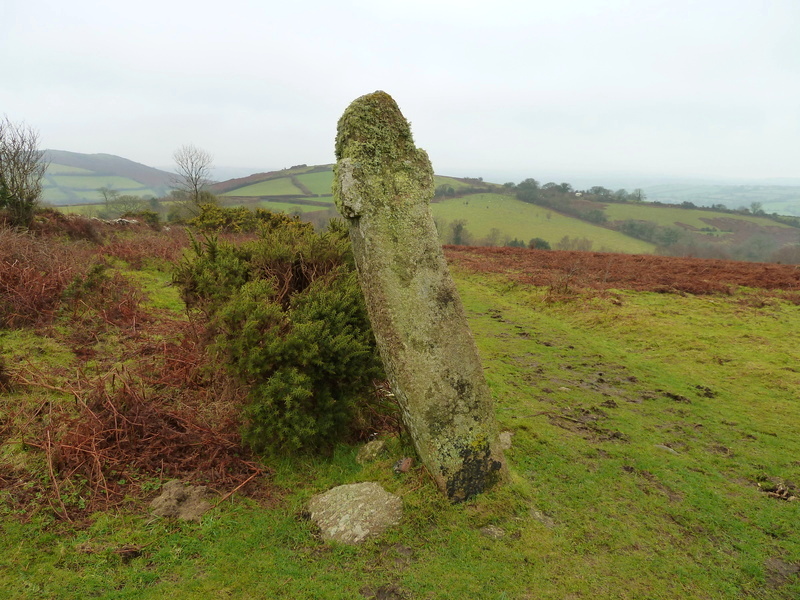
Week Down Cross submitted by Bladup on 3rd Mar 2016. Week Down cross at SX71168653.
(View photo, vote or add a comment)
Log Text: Week Down Cross: We left the car by the Shorter Cross and continued the 250m up the road by foot; in actual fact there is a large grassy area on the moor here, and another car with a disabled passenger pulled onto the grass whilst we were there. Whilst the cross itself is only 9m from the road, there is a bank immediately at the edge of the road to step up to the common.
This cross is in a really lovely location, sitting by the edge of the common/moor, with great views over the moors to Chagford.
I had to be careful about photographing this cross, as to the west there was a camp site with some really brightly coloured tents which took over the photo, so I aligned myself to these were either hidden behind the cross, or behind the gorse bushes!
F H Starkey in his 1983 book “Dartmoor Crosses & Some Ancient Tracks” describes this cross as :”it consists of a tall rectangular shaft of granite, six feet nine inches tall. It has a rounded head and two very short arms have been cut out of the shaft. A Maltese Cross is cut on each face; one of these is in line with the shaft of the cross which is inclined at an angle to the ground, the other is at right-angles to the ground. This rather strange fact led Ormerod (who described the cross in 1874, having know it from at least 1859) to conjecture the crosses had been carved after the cross was erected and had settled down to its out of perpendicular stance Ormerod also tells us that the cross was in danger of falling in 1867 and that it was moved back from the road a little but that its original angle of inclination was repeated when it was re-erected. He says too, that there was a project afoot to move the cross and use it to make a foot-bridge; happily it was spared this fate”.
Meacombe Cist
Trip No.131 Entry No.5 Date Added: 4th Jun 2019
Site Type: Burial Chamber or Dolmen
Country: England (Devon)
Visited: Yes on 12th May 2019. My rating: Condition 3 Ambience 4 Access 4
Meacombe Cist submitted by hamish on 14th Nov 2004. A fine little chambered tomb, found by chance.
(View photo, vote or add a comment)
Log Text: Meacombe Cist: We'd arrived in Devon in a torrential downpour, although this had cleared in the evening. The sheer amount of rain might have contributed to ripping away the road surface at the edge of the road leading to this burial chamber.
The roads to this burial chamber were atrocious, with very deep potholes and a centre ‘bank’ of earth and grass, which at times tickled the underneath of the car - we debated about turning back at one point. The road was so narrow and parking so difficult that we parked in the next field gate to the north of the cist. Andrew stayed with the car whilst I let myself into the adjacent field, which also looked as if it had archaeology (but are just rocky outcrops, nothing on Pastscape or HE), but didn’t stop as Andrew needed to move the car. Took some quick photos, then ran back.
I was worried about trespassing, but there was a well worn tractor track into an open gate into the next field, then a track from the gate to the burial chamber.
We had hoped to see the enclosure and hut circle to the south west, but no way of stopping, nor could we see any sensible places to stop.
Note: I only found this a 'short walk on the footpath' from the adjacent field.
Hunter's Tor Fort
Trip No.131 Entry No.6 Date Added: 4th Jun 2019
Site Type: Hillfort
Country: England (Devon)
Visited: Yes on 12th May 2019. My rating: Condition 2 Ambience 4 Access 3

Hunter's Tor Fort submitted by Creative Commons on 8th Feb 2012. The gorse bushes are on the degraded bank of the hilltop fort above the northern end of Lustleigh Cleave. Beyond the wall and gate can be seen Moretonhampstead.
Copyright Derek Harper and licensed for reuse under the Creative Commons Licence
(View photo, vote or add a comment)
Log Text: Hunter's Tor Iron Age Hillfort: A very pleasant walk from the end of the lane at SX 75702 83203, up a public bridlepath, the path cutting through a farmyard higher up the hill. Continuing up the hill, we eventually reached a long stone wall with a gate leading into the fort. At its northern end (SX 76043 82474) there was a large rocky outcrop with a balanced rock.
Most of the ramparts and banks, whilst ruined, are still visible, and there are glorious views over to the west from most of the hillfort.
To its south eastern side, there appear to be rows of stones/banks which might be the remains of old field systems.
Some of the outer banks are cut by a long dry stone wall on its eastern side; looking over these continue in the field behind. We let ourselves out of the gate into the fort at its north eastern side then let ourselves into the gate into the field to take a quick photo of the continuing banks.
There were lots of walkers and mountain bikers walking through the fort. Only one other couple we saw actually appeared to be looking for the features within the fort; others either sat and picnicked by the outcrop, or simply rode through.
Watching Place Waymarker
Trip No.130 Entry No.1 Date Added: 22nd May 2019
Site Type: Marker Stone
Country: England (Devon)
Visited: Yes on 11th May 2019. My rating: Condition 3 Ambience 3 Access 5
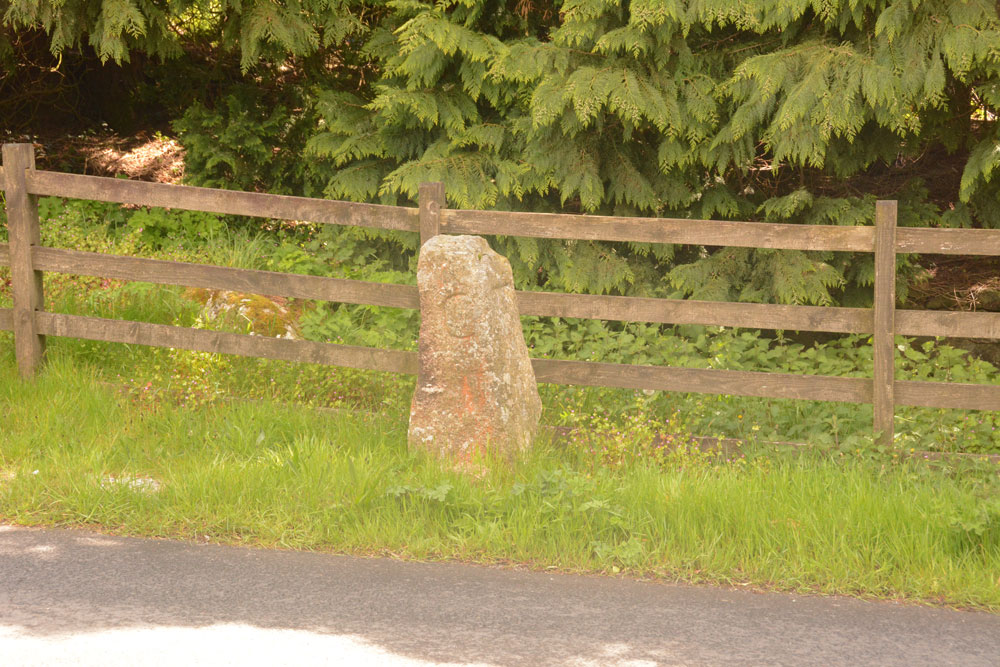
Watching Place Waymarker submitted by Anne T on 22nd May 2019. The Beetor/Watching Place waymarker. This stone dates only to the 18th century, but marks the original site of the Beetor Cross, now located some 100m to the south.
(View photo, vote or add a comment)
Log Text: Watching Place Waymarker/original site of Beetor Cross: Having seen the OS map and sorted out the Pastscape entries, I finally realised that this 'standing stone' was where the cross had originally been located.
Our first stop today was to go and photograph it so I could complete the Beetor Cross entry. It was nice to understand the relationship between the waymarker stone and the wayside cross, although it too me a while to understand the confusion between the names (HE calls the waymarker the Beetor Cross and the cross the Watching Place Cross).
I had to be careful photographing the front of the cross as cars sped quickly at irregular intervals.
Leeper Cross
Trip No.130 Entry No.2 Date Added: 24th May 2019
Site Type: Ancient Cross
Country: England (Devon)
Visited: Yes on 11th May 2019. My rating: Condition 2 Ambience 3 Access 4
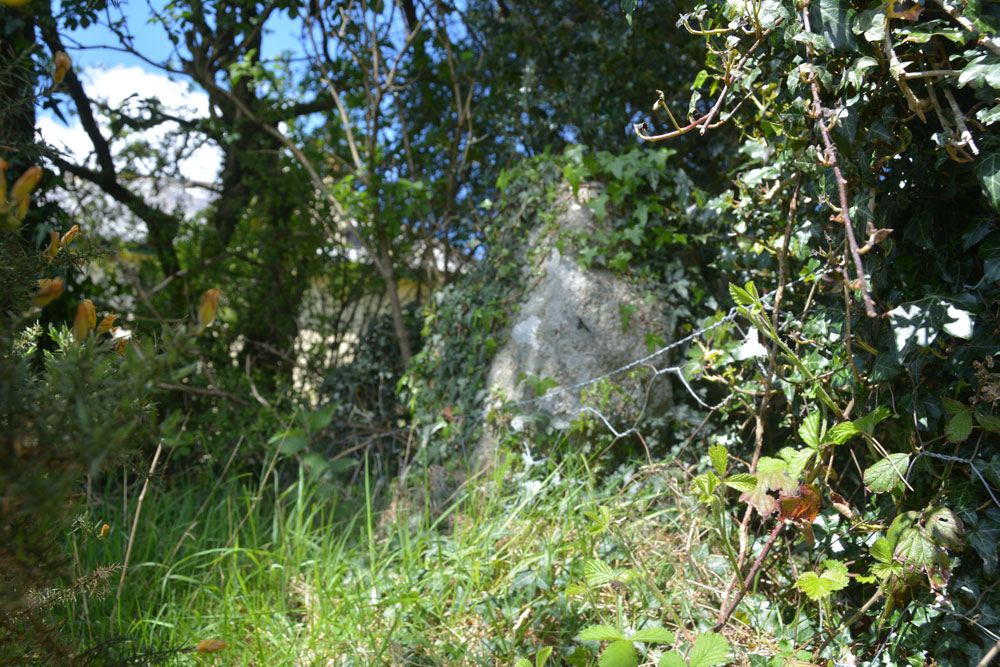
Leeper Cross submitted by Anne T on 24th May 2019. Trying to get a good close up of the south face of the Leeper/Leapra Cross, although it was deep in shade at this time, and I used the flash.
(View photo, vote or add a comment)
Log Text: The Leeper/Leapra Wayside Cross: We had problems locating this cross, so I ended up walking up the driveway up to Moorgate Farm. Just to the right hand side of the gate, I thought I identified an ivy covered cross head shape. Andrew didn’t believe me, so I let myself through the gate and had a closer look. Now I wasn’t convinced.
I heard voices through the hedge, so went in search of the voices, and ended up speaking to a young man who lived in the cottage. He said he knew where the cross was, and took us to the corner of the wall where my ivy covered shape was. This was indeed the Leeper Cross.
He told me that the cross had been moved from where it had been found at Moorgate Farm to Bovey Castle (“which isn’t a castle”), but there had been dissention so it had been moved back to this spot. His family had tried to get the cross located back to its original spot (at Moorgate Farm?) but “there doesn’t seem to be an appetite for it”.
He was happy to leave me to photograph the very ivy covered cross whilst he went back to erecting his new greenhouse.
Challacombe Cross Settlement
Trip No.130 Entry No.3 Date Added: 24th May 2019
Site Type: Ancient Village or Settlement
Country: England (Devon)
Visited: Yes on 11th May 2019. My rating: Condition 3 Ambience 4 Access 4

Challacombe Cross Settlement submitted by TheCaptain on 5th Mar 2017. A photo of what I have called Shapley Common Hut, taken during a walk at Easter 1988.
I dont believe this would be at the location given on the Portal sitepage, but more to the northeast, around SX697830, as our walk first took us south along the ridge to Hookney Tor and Grimspound
(View photo, vote or add a comment)
Log Text: Challacombe Cross/Shapley Common Hut Circles: Having seen quite a few hut circles in Northumberland, I wasn’t expecting much from this site – a few stony-outlined circles in the bracken, but what a lovely surprise this site was – hut circles with very large boulders making up the perimeter. It turned out this was just a taster of the sites we saw around Merrivale, Stanlake and Kestor.
From the Leeper/Leapra Cross, we walked WSW along the B3212 to SX 70049 83251, where an old hollow way/track leads up onto the moor. Armed with the GPS for the first part of the walk,
The hut circles can be clearly seen on UK Grid Reference Finder. The HE entry gives a location just to the west of the line of hut circles – they run from SX 69750 83029 in the south to SX 69779 83133 in the north. Unfortunately the GPS attachment for my camera seems to have stopped working, so I’m waiting for a plan of this site to arrive, so I can assign grid references to each of the hut circles.
Walking to the top hut circle, looking down towards the viewpoint just off the B3212 Princetown Road at SX 69834 83454, it was possible to get a photo of the hut circles all in a line down the hill. Whilst we saw many people head off northwards across the moor, there was no-one else on or near this site at all.
We must have spent a good hour photographing the hut circles and looking at the medieval banks and ditches, some of which cut the hut circles.
Moretonhampstead Cross
Trip No.130 Entry No.4 Date Added: 24th May 2019
Site Type: Ancient Cross
Country: England (Devon)
Visited: Yes on 11th May 2019. My rating: Condition 3 Ambience 3 Access 5
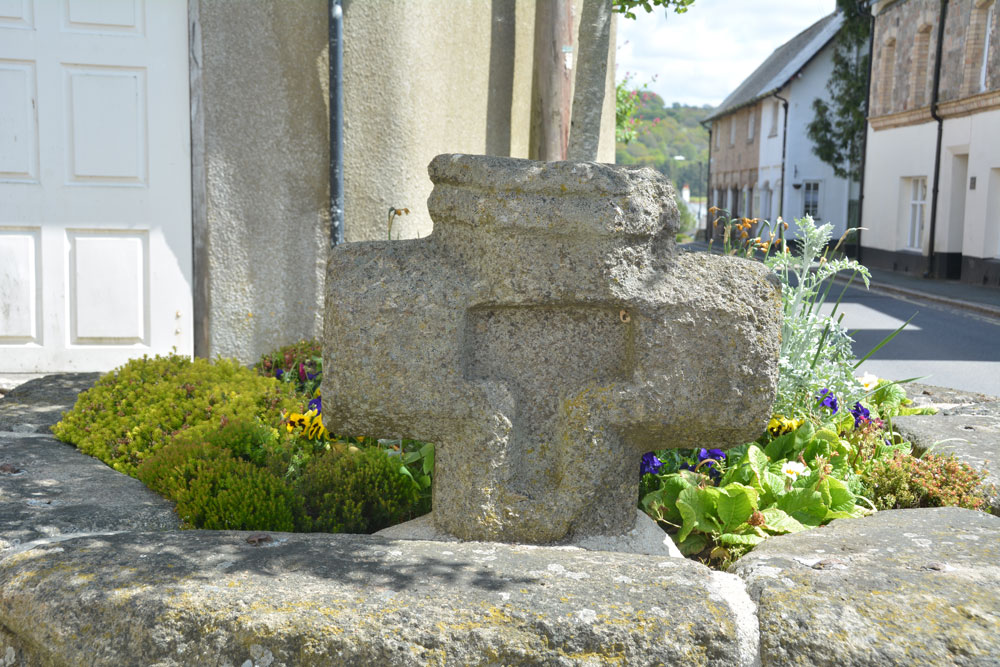
Moretonhampstead Cross submitted by Anne T on 24th May 2019. The eastern side of the cross head, with its T shaped recess (Pastscape describes it as cross shaped).
(View photo, vote or add a comment)
Log Text: Moretonhamstead Village Cross: The remains of this old village cross can be found, surprisingly, on Cross Street, outside the gate at the south side of the churchyard. I confess I had not expected to see a wayside/village cross mounted in a large flower bed! I got some strange looks from locals and visitors photographing this flower bed from different angles.
We then went to explore the church (St Andrew's) then for soup and a cup of tea in a nearby café (the Gateway Tearooms) with superb table service. Carrot and ginger soup with freshly made soda bread. Yum!
Horspit Cross
Trip No.130 Entry No.5 Date Added: 24th May 2019
Site Type: Ancient Cross
Country: England (Devon)
Visited: Yes on 11th May 2019. My rating: Condition 3 Ambience 4 Access 5
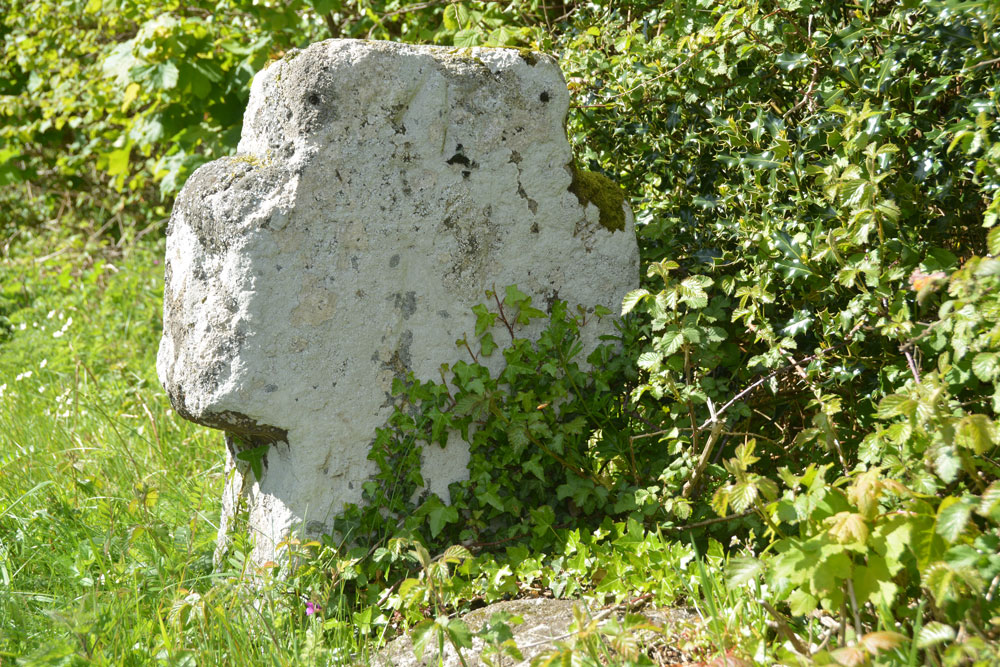
Horspit Cross submitted by Anne T on 24th May 2019. The eastern side of this short, stumpy cross. If there was an initial carved on this face, it was not visible (to us) on the day, or from looking at the photographs later. This is a bench mark on the front of this cross. The top of it is in the centre of the front, and just peeps out above the vegetation growing around its base.
(View photo, vote or add a comment)
Log Text: Horspit Cross, North Bovey: This was to be an afternoon of ‘cross sighting’, with the weather gradually turning from a bright, sunny day to a dull, almost misty day by the time we’d finished.
This squat, small cross sits right on a road junction, with a large boulder immediately adjacent. We managed o park in the entrance way to a new, but abandoned house, which had a tarmacked driveway next to the road, but large, padlocked gates to stop intruders.
The large boulder in front of the cross on the Pastscape photograph I thought looked like part of the cross shaft is in fact just a boulder. The cross has a bench mark on it, which we tried to find; Andrew eventually find it on the ‘front’ of the cross, the top of it showing only just above the vegetation that had grown up around the cross.
Sanduck Cross
Trip No.130 Entry No.6 Date Added: 25th May 2019
Site Type: Ancient Cross
Country: England (Devon)
Visited: Yes on 11th May 2019. My rating: Condition 3 Ambience 4 Access 4

Sanduck Cross submitted by Anne T on 25th May 2019. Getting a bit closer to the cross, it slopes a little. Historic England says this is probably due to disturbance by tree roots around it. The cross was moved to its current location after a fire at Sanduck Farmhouse in 1901, and has been fitted into a modern socket stone.
(View photo, vote or add a comment)
Log Text: Sanduck Wayside Cross: We were going past this spot to get to the next cross on our list, when we spotted this on the OS map, so decided to stop and look for it. We parked outside a very lovely house built around a courtyard; as the road was very narrow, we pulled into a small tarmacked area opposite the house, thinking we’d only be there for a couple of minutes. As we stopped, a lady came out of the house and into her garden. The cross was on a bank at the top of the grass verge, just to the western end of her garden. We said hello to the lady and she replied, and wandered back to the house.
Because the cross was immediately adjacent to private land and against a hedgerow with tall trees around, we didn’t ask to get into the field behind as the back of the cross would have been hidden by the hedge.
Higher Combe Cross
Trip No.130 Entry No.7 Date Added: 30th May 2019
Site Type: Ancient Cross
Country: England (Devon)
Visited: Saw from a distance on 11th May 2019. My rating: Condition 3 Ambience 3 Access 4

Higher Combe Cross submitted by Anne T on 30th May 2019. Andrew (husband) balanced on top of the low stone wall between the minor road to Lustleigh and Cross Park Field to get this photograph of the cross head, from about 100m away. Not the best focused of photographs, but the closest we could get.
(View photo, vote or add a comment)
Log Text: Higher Combe Cross: If we could have obtained access to this cross, access would have been a short walk across a field of improved pasture. Shame the gate was double-chained with two electric fences virtually up against the gate. Lovely horse in the field, though.
Andrew resorted to standing on top of the low stone wall just to the south of the cross, where there was a sufficient enough gap in the trees/hedges to see through. A shame, because it looked as if it was in such a lovely location, just above a small stream, and against an old hollow way.
Datuidoc's Stone
Trip No.130 Entry No.8 Date Added: 30th May 2019
Site Type: Early Christian Sculptured Stone
Country: England (Devon)
Visited: Yes on 11th May 2019. My rating: Condition 3 Ambience 3 Access 4
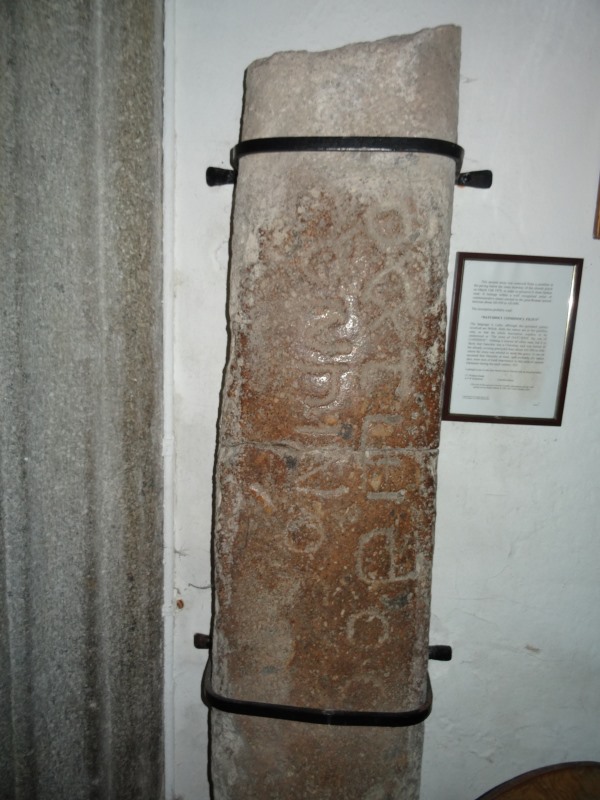
Datuidoc's Stone submitted by AngieLake on 5th May 2018. Another view of the stone in Lustleigh Church today, during the May Day celebrations. (Not to be missed on such a sunny, lovely, day!)
(View photo, vote or add a comment)
Log Text: The Writhelstan inscribed stone, St John The Baptist, Lustleigh: Expecting this to be the prettiest village in Devon, I was a little surprised to find I didn’t agree. The church is right in the middle of the village, and we managed to park by the south wall of the churchyard, immediately opposite the village pub.
Going into the church, the Writhelstan stone was stuck on the west wall of the nave in between, and partly hidden by, a gas heater on its south side, and wooden stacking chairs to its northern.
We couldn’t ascertain if the churchyard was oval/circular as a road had been cut to its northern side.
Some lovely old grave slabs in the floor of the chancel, northern chapel and nave. Interesting rood screen with pomegranates and heads. Whilst we were in the church, there were around four to five other sets of visitors, none of whom looked at this inscribed stone, which I thought was odd, but then it was well hidden unless you knew what to look for.
There was also a cross on the village green, which looked to be modern. Could not find this on Pastscape.
There was a photo frame with some information about this stone, which must have been on the wall, but had recently fallen off and the glass had shattered. I carefully moved it from the floor onto the top of the heater and photographed it.
“This ancient stone was removed from a position in the paving below the inner doorway of the church porch on March 13th 1979, in order to preserve it from further wear. It belongs with a well recognised series of commemorative stones erected in the post-Roman period between about AD 450 to AD 600.
The inscription probably read:
“DATUIDOCI CONHINOCI FILIUS”
The language is Latin, although the personal names involved are British. Both the names are in the genitive case, so that the whole inscription requires to be understood as “The stone of DATUIDOC the son of CONHINOC”. Nothing is known of either man, but it is likely that Datuidoc was a Christian, and was buried in the already existing graveyard here about AD 550 to 600, where the stone was erected to mark his grave. It can be assumed that Datuidoc at least, and probably his father also, were men of local importance in this area of eastern Dartmoor during the sixth century AD”.
Lustleigh is one of only four church sites in Devon with an inscribed stone
J.C. Wallace Kemp & A.P.W. Robertson (Churchwardens).
After walking around the church, and photographing the modern cross on the church green, we adjourned to the pub, The Cleave, opposite the church. As it was such as warm evening, we sat in the garden around the back of the pub, listening to the myriad of bird song.
Bishop's Stone (Lustleigh)
Trip No.130 Entry No.9 Date Added: 1st Jun 2019
Site Type: Ancient Cross
Country: England (Devon)
Visited: Yes on 11th May 2019. My rating: Condition 3 Ambience 3 Access 5
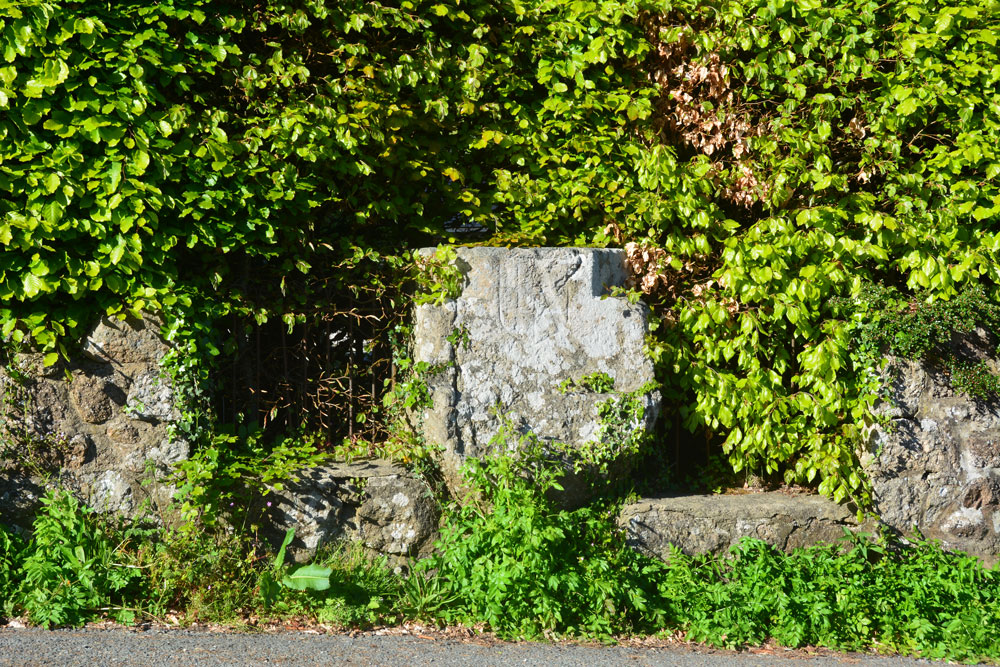
Bishop's Stone (Lustleigh) submitted by Anne T on 1st Jun 2019. The Bishop's Stone, seen from part way across this busy, minor road. The Pastscape photograph shows the stone set against an iron railing; a substantial hedge has since grown up around it.
(View photo, vote or add a comment)
Log Text: Bishop's Stone, Lustleigh: This stone is on a corner of a busy road junction of three minor roads– I needed to pick my time to step part way across the road to photograph the stone from the front. The metal railing shown in the Pastscape photo is now largely hidden by a beech hedge. The stone goes about around a metre or so back into the garden of the house. It’s a lot bigger than it looks at first glance. We were also lucky that the bright sunlight also helped to show up the incised shield.
South Harton Cross
Trip No.130 Entry No.10 Date Added: 1st Jun 2019
Site Type: Ancient Cross
Country: England (Devon)
Visited: Yes on 11th May 2019. My rating: Condition 3 Ambience 4 Access 5

South Harton Cross submitted by Anne T on 1st Jun 2019. This wayside cross leans against a drystone wall, just west of the gateway into South Harton Farm. It has been split into two and re-assembled at some point in its past, but is a nice specimen, and it was worth braving the tiny lanes to find it.
(View photo, vote or add a comment)
Log Text: South Harton Wayside Cross: As we drove along the minor roads from the Bishop’s Stone towards South Harton Farm, the sun went in and a haze started to drift across the fields and it started to become very chilly.
This cross simply leans against the dry stone wall, just to the west of the gated driveway leading to South Harton Farm. It has very obviously been cemented together, but is none-the-less spectacular, and I’m glad we braved the narrow lane to find this cross.
Out of curiosity, I walked to the gate and looked to see if the cross was visible from the other side of the wall, but it is hidden by the drystone wall and the hedge.
Chagford Druid's Well
Trip No.131 Entry No.1 Date Added: 3rd Jun 2019
Site Type: Holy Well or Sacred Spring
Country: England (Devon)
Visited: Yes on 11th May 2019. My rating: Condition 3 Ambience 4 Access 5
Chagford Druid's Well submitted by cazzyjane on 9th May 2012. Druid's Well, Chagford. Looks like a tiny quoit but has lots of clear water running from it.
(View photo, vote or add a comment)
Log Text: Druid's Well, near Chagford: Our first stop of the day, with bright sunshine and deep shadows. As we approached the well, this was our first of several encounters with a very friendly Granny looking after granddaughter on skittish, but beautiful, horse. Granny was following both round in a car, making sure horse and rider were OK on these narrow lanes. We passed them several times, and met Gran again later in the day outside her farm, when we were driving towards the burial chamber, when we needed to get past a large tractor and trailer going down the narrow, and very potholed lanes.
This well is just outside a property called Wellpark. At first it looks like a grass covered mound, but looking closer there is a well chamber, a large capstone and an exit water channel. On looking at the Pastscape entry, they mention another well recorded on the OS maps, only 9m away, built of an iron post and slate structure, now infilled. We didn't see this, although there was plenty of farm machinery and piles of stones and grit at the sides of the road.
Rolleston Cross
Trip No.129 Entry No.1 Date Added: 21st May 2019
Site Type: Ancient Cross
Country: England (Nottinghamshire)
Visited: Yes on 10th May 2019. My rating: Condition 3 Ambience 3 Access 5
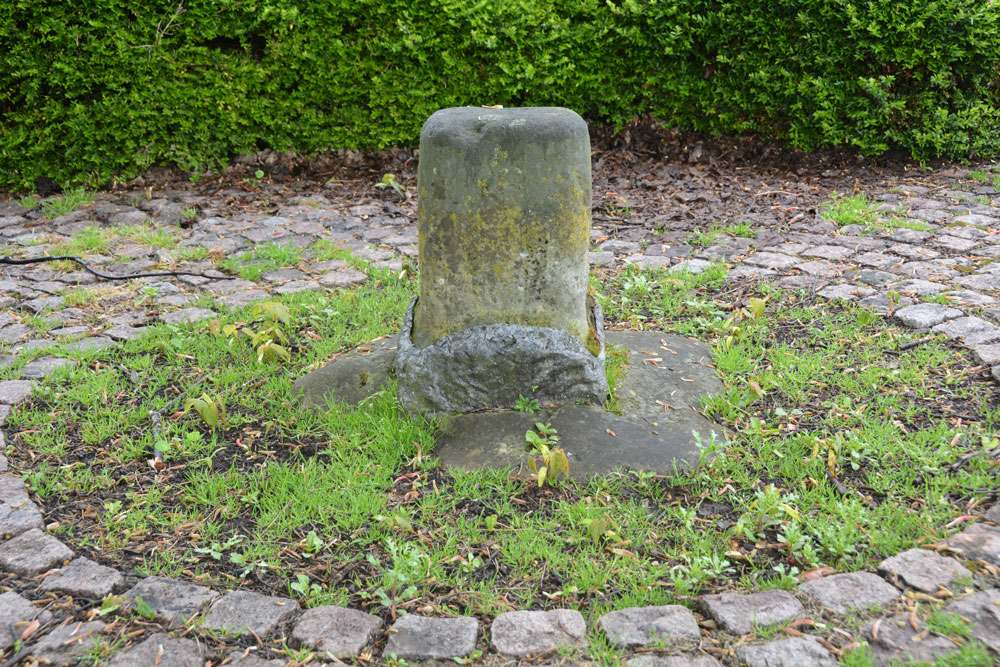
Rolleston Cross submitted by Anne T on 21st May 2019. Close up of the stump of the Rolleston Village Cross. Pastscape tells us it once had shields carved into it, although these are no longer visible, and they do not tell us who these belonged to. Dated to the 14th century, the local stocks were once said to be nearby.
(View photo, vote or add a comment)
Log Text: Rolleston Cross: This was our first stop on our way down to Dartmoor. Having stopped off in Newark for a very early breakfast, we arrived in Rolleston at 08:30, only to find (not surprisingly!) that the church had not yet been opened. After having photographed the sun dial in the churchyard of Holy Trinity, we walked up to find this old village cross, which I completely missed the first time round, as it blended in with the surrounding pavement and benches!
The very sad remains of an old village cross, but another site to have ticked off the list. By the time we'd photographed this cross stump, we walked back to Holy Trinity to find it now open.
Holy Trinity (Rolleston)
Trip No.129 Entry No.2 Date Added: 21st May 2019
Site Type: Ancient Cross
Country: England (Nottinghamshire)
Visited: Yes on 10th May 2019. My rating: Condition 3 Ambience 4 Access 4
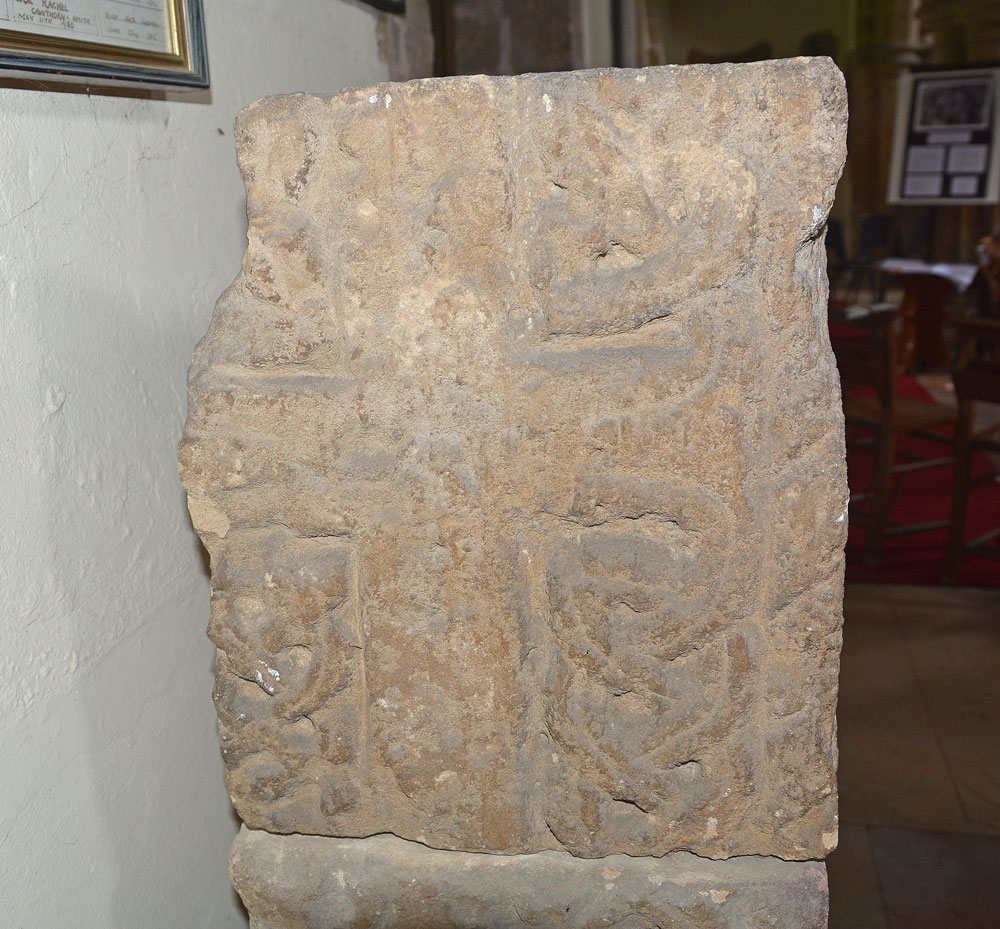
Holy Trinity (Rolleston) submitted by Anne T on 21st May 2019. The western side of the top-most block of the three making up the remains of this stone cross.
(View photo, vote or add a comment)
Log Text: Cross Shaft Fragments and Cross Slabs, Holy Trinity, Rolleston: By the time we’d photographed the sundial in the churchyard then walked up to the village cross, the church had been opened (thankfully) and we let ourselves in. The cross shaft was immediately opposite the south door into the church, although in a really difficult position to photograph (between a heavy wooden desk with information leaflets and a fire extinguisher). The most ornate section of the cross was to its western side, so after Andrew had moved the chairs, I virtually had to squeeze myself in next to the desk and squat down as best I could to capture the carvings – not the most elegant of positions!
It wasn’t until after I had photographed the cross and was making my way towards the fragments in the eastern wall of the northern aisle that I realised the chairs in the church had been set up in a labyrinth pattern. We did have to move some of the chairs to access several parts of the church, but made sure we put the chairs back exactly where we found them.
Thank goodness I had my printouts with Peter Ryder’s drawings and descriptions, as we would have missed a lot here! We’d spotted one or two of the most obvious carved stones built into the external fabric. However, now knowing how much was on the external walls, we went round the outside again and spotted so much more.
